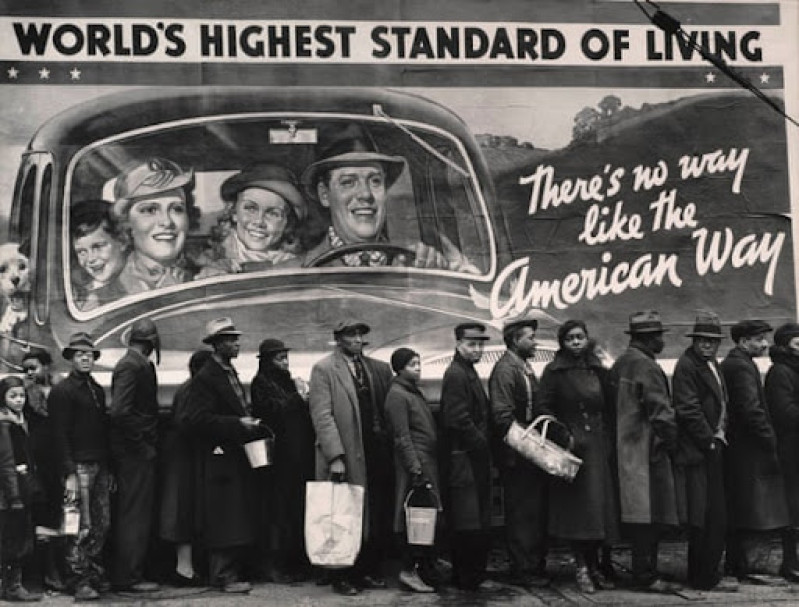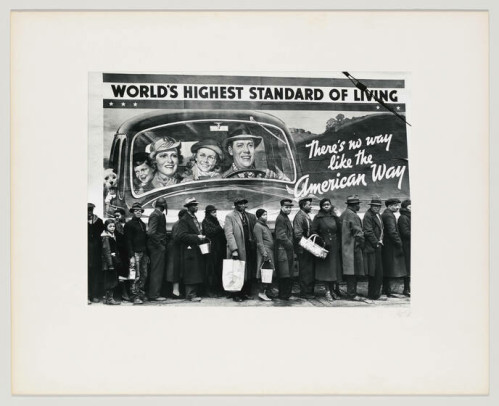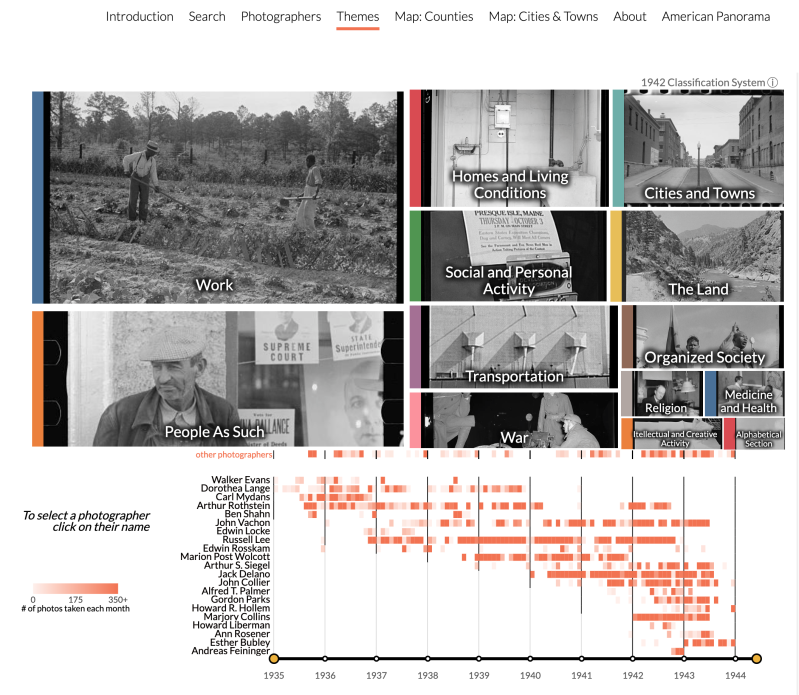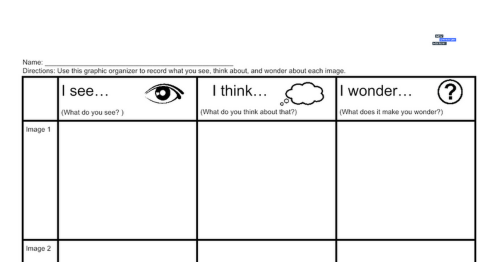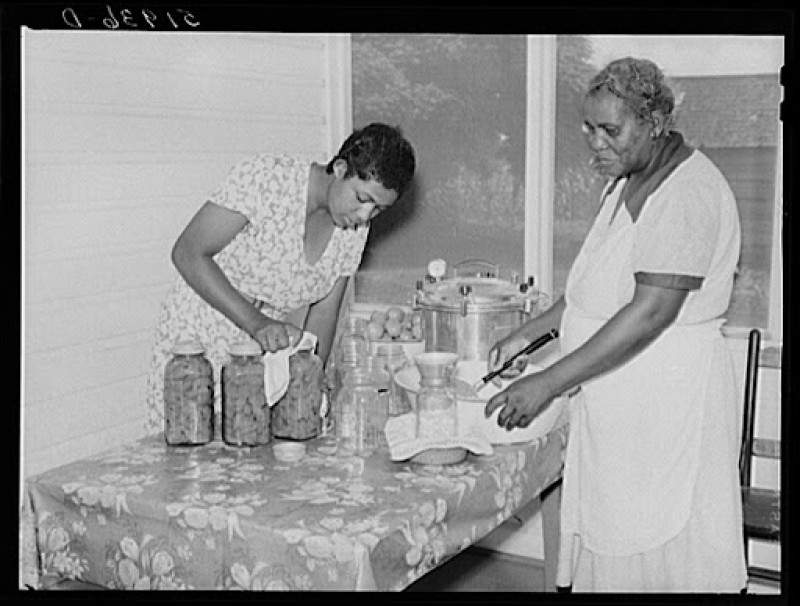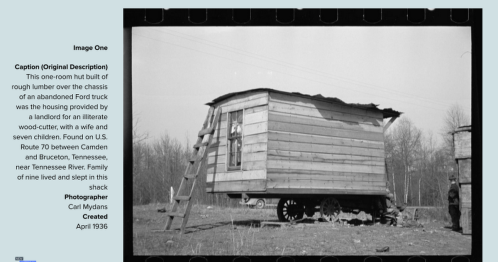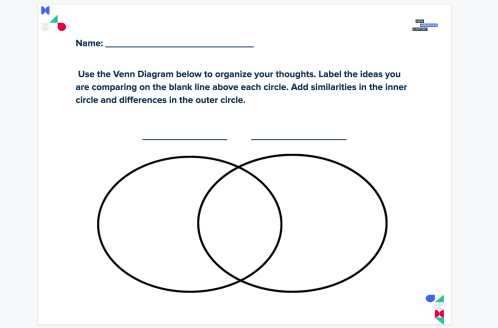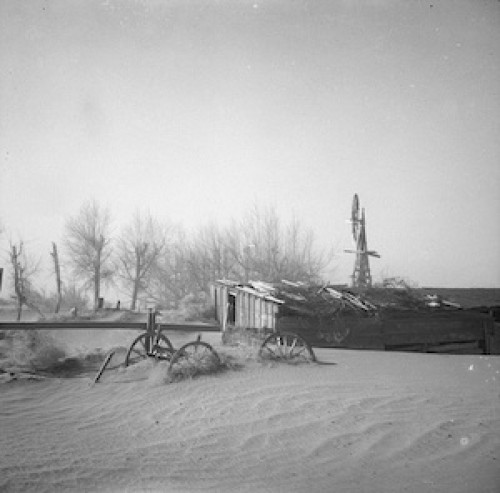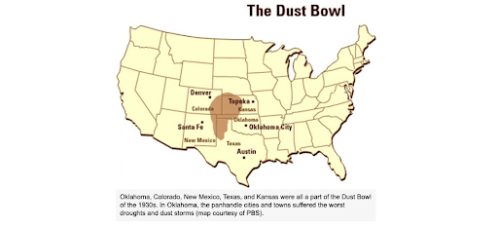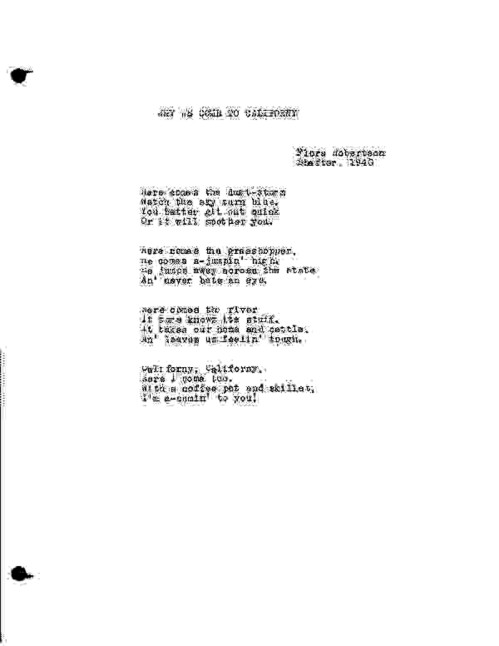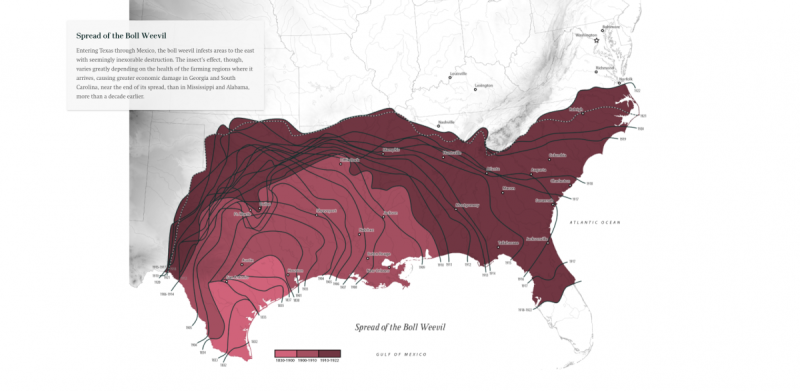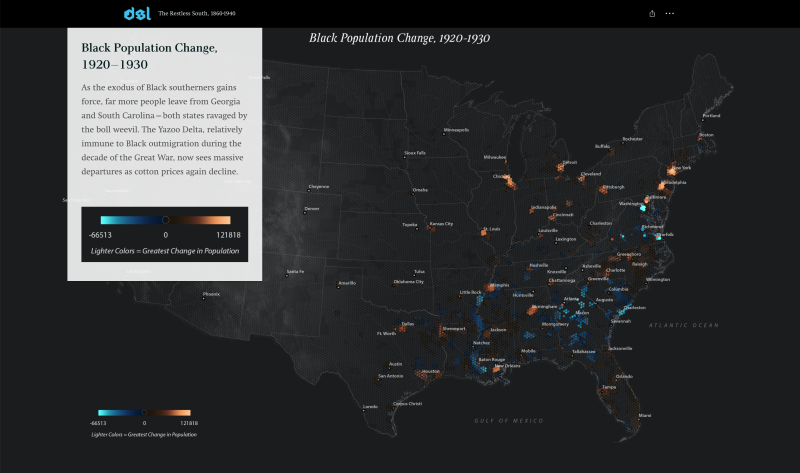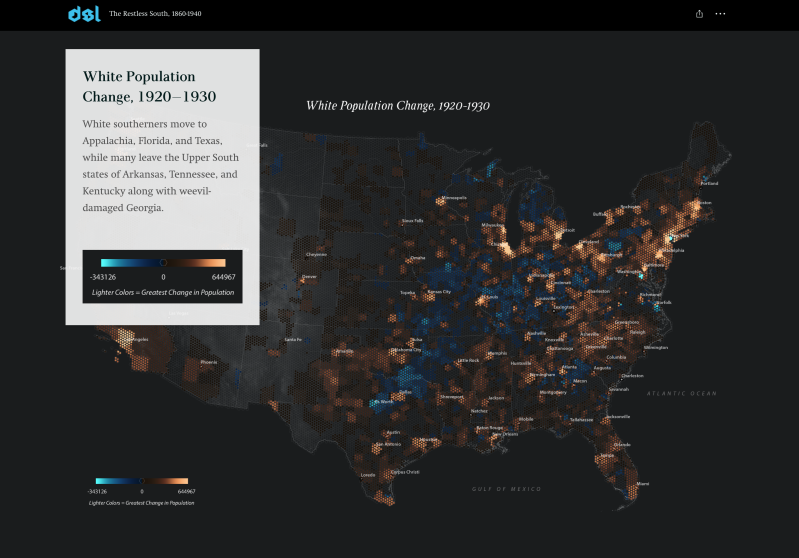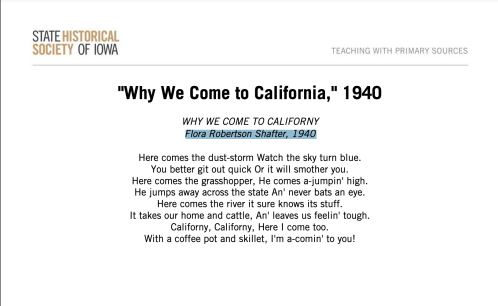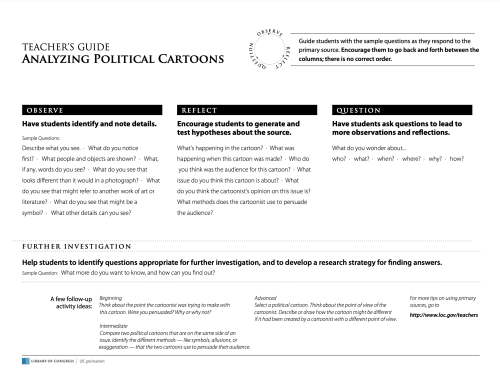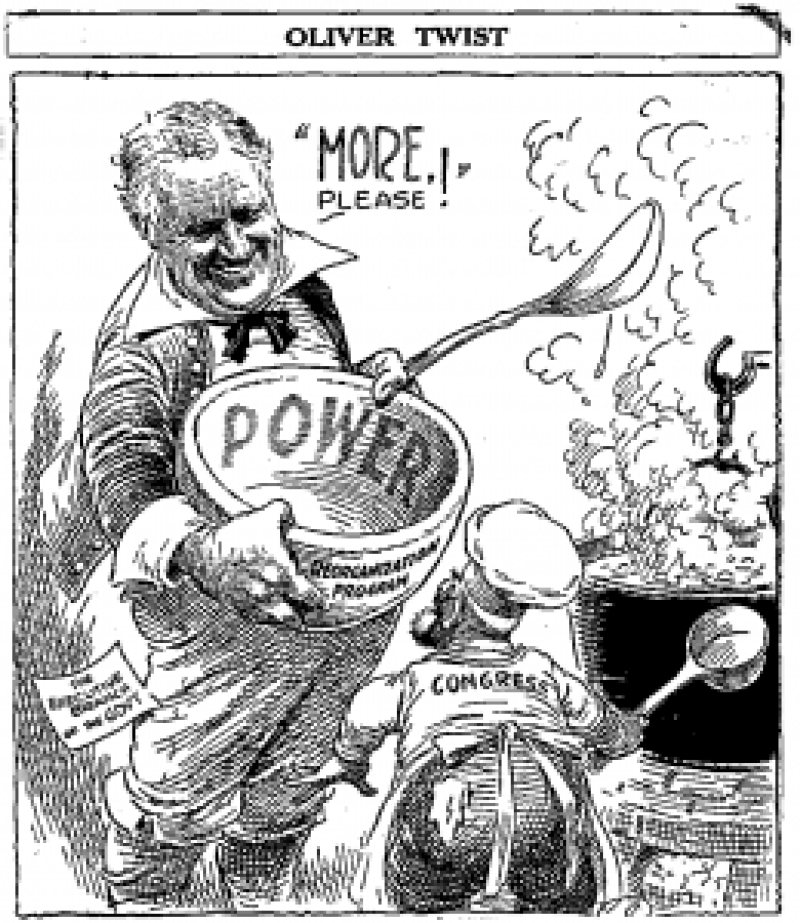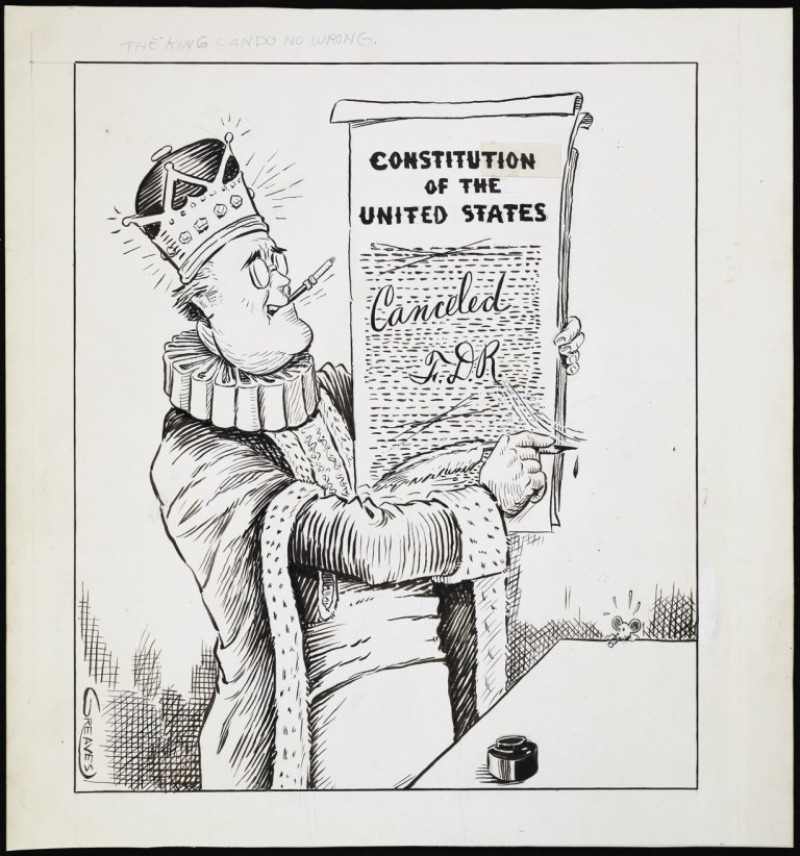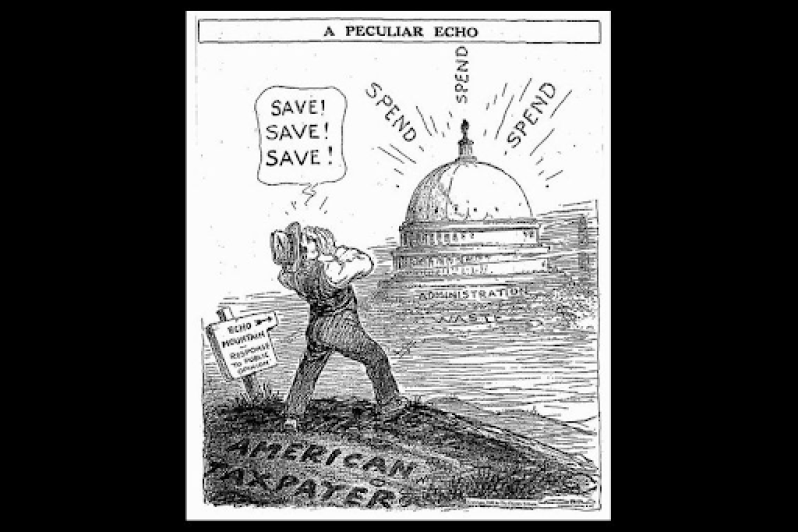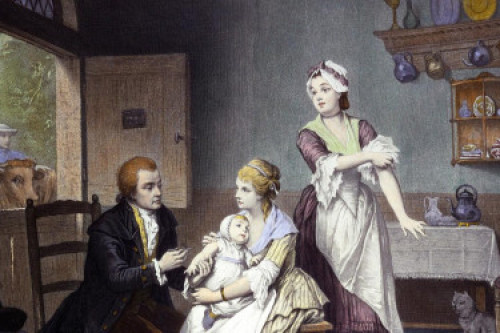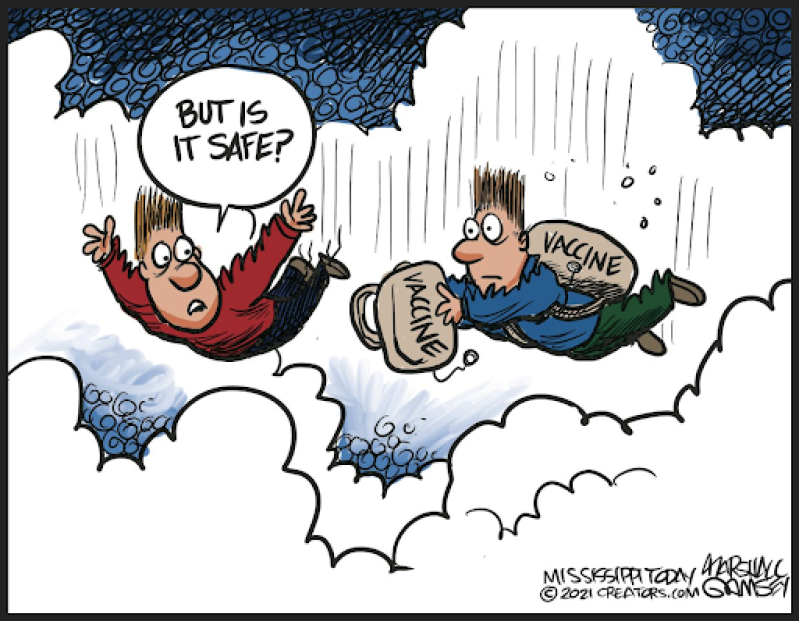This work by New American History is licensed under a Attribution-NonCommercial-ShareAlike 4.0 (CC BY-NC-SA 4.0) International License. Permissions beyond the scope of this license may be available at newamericanhistory.org.
Visualizing The Great Depression
View Student Version
Standards
C3 Framework:D2.His.3.6-8. Use questions generated about individuals and groups to analyze why they, and the developments they shaped, are seen as historically significant.D2.His.3.9-12. Use questions generated about individuals and groups to assess how the significance of their actions changes over time and is shaped by the historical context.
National Council for Social Studies:Theme 3 - PEOPLE, PLACES, AND ENVIRONMENTSTheme 6 - POWER, AUTHORITY, AND GOVERNANCETheme 7 - PRODUCTION, DISTRIBUTION, AND CONSUMPTION
National Geography StandardsStandard 4. The physical and human characteristics of places.Standard 6. How culture and experience influence people’s perceptions of places and regions.Standard 12. The processes, patterns, and functions of human settlement.
Teacher Tip: Think about what students should be able to KNOW, UNDERSTAND and DO at the conclusion of this learning experience. A brief exit pass or other formative assessment may be used to assess student understandings. Setting specific learning targets for the appropriate grade level and content area will increase student success.
Suggested Grade Levels: Middle and High School (6-12)
Suggested Timeframe: 3 class sessions, 45 minute class periods
Suggested Materials: Internet access via laptop, tablet, or mobile device
Key Vocabulary
Backstory - a story that tells what led up to the main story or plot
Billboard - a very large board where advertisements are shown, especially on the side of a road or highway
Black Tuesday - the day the New York Stock Exchange crashed (October 29th, 1929)
Boll Weevil - a snout beetle, Anthonomus grandis, that attacks the bolls of cotton
Bread Line - (also written as breadline) - a line of people waiting for free food, often at a public space referred to as a soup kitchen as soup and bread were distributed frequently to those in need.
Calamity - an event that causes great harm and suffering
Contemporary - marked by characteristics of the present time period
Default - a failure to fulfill an obligation to repay a debt
Depopulation - the reduction of the number of persons in a place
Dust Bowl - an area of the southern Great Plains that suffered from a lack of rain (drought), poor farming practices, and damaging dust storms
Eviction - the dispossession of a tenant of leased property by force or legal process
Federal Reserve - a federal agency that regulates banking policies and practices
Food Insecurity - inability to consistently access or afford adequate food
Great Depression - the severe economic crisis that took place in the 1930s
Hoovervilles - shanty towns (built out of boxes, tents, etc.) during the Great Depression named for President Hoover because of his administration’s failure to provide relief
Irony - a figure of speech, or use of words with an interesting or surprising result than what one would normally expect, or what the real thing or situation is, often presented in a humorous or dramatic way
Migrant Worker - a person who moves from place to place to find work, often working seasonally in agriculture
Out-migration - the action of leaving one place to settle in another, especially within a country.
Propaganda - information used to promote or publicize a particular political cause or point of view, especially that of a government
Public Works - government-funded infrastructure projects that include highways, parks, and libraries
Recovery - the process of returning to a normal or usual state
Reform - changes to a law, social system, or institution
Relief - help for the needy, including financial assistance, food, clothing, or shelter
Stock - shares of ownership in a company that can be bought and sold
Tag - a label attached to someone or something for the purpose of identification or to give other information
The New Deal - President Franklin D. Roosevelt’s program to help solve the economic problems triggered by the Great Depression
Treemap - a visual representation of data, usually expressed as rectangles. Each grouping is represented by a rectangle with an area proportional to its value. (see context as used in the learning resources.)
White-collar - relating to people who work in administrative, managerial, and other office capacities
Works Progress Administration (WPA) - President Franklin D. Roosevelt’s work program, engineered as part of the New Deal for the purpose of providing jobs for millions of unemployed Americans during the Great Depression
Work Relief - programs designed under the New Deal to create jobs for the unemployed
Read for Understanding
Teacher Tips:
This Learning Resource includes language in the body of the text to help adapt to a variety of educational settings, including remote learning environments, face-to-face instruction, and blended learning.
If you are teaching remotely, consider using videoconferencing to provide opportunities for students to work in partners or small groups. Digital tools such as Google Docs or Google Slides may also be used for collaboration. Rewordify helps make a complex text more accessible for those reading at a lower Lexile level while still providing a greater depth of knowledge.
For in-person learning, you may use Turn and Talk to allow students to work with an “elbow partner” for brief collaborations. In addition, this Learning Resource uses “Thinking Routines” from Project Zero, a research center at the Harvard Graduate School of Education that has developed learning strategies that encourage students to add complexity to their thought processes. For an overview of Project Zero’s methodology, you may want to read its Exploring Complexity Bundle. Specifically for this lesson, students will use the See, Think, Wonder thinking routine, with a student template, a Venn Diagram, and the Great Depression Photo Series slides template provided.
The Library of Congress Primary Source Analysis Tool is used to examine political cartoons from the New Deal era. You may wish to provide a paper copy to your students or use a fillable .pdf version for students working in a digital learning environment.
These Learning Resources follow a variation of the 5Es instructional model, and each section may be taught as a separate learning experience, or as part of a sequence of learning experiences. We provide each of our Learning Resources in multiple formats, including web-based and an editable Google Doc for educators to teach and adapt selected learning experiences as they best suit the needs of your students and local curriculum. You may also wish to embed or remix them into a playlist for students working remotely or independently.
For Students:
The Great Depression is often considered the worst economic event in American history. The Great Depression started with the stock market crash of 1929 and lasted until 1946 and the end of World War II. You will explore these events through powerful images, audio content, interactive maps, and political cartoons.
Engage:
How do images from the Great Depression show conflicting realities of life in America?
In this lesson, you will learn about a period of American history known as the Great Depression. For many Americans, this economic disaster was a time of great despair and loss. Many people lost jobs, property, homes, and a sense of identity. Despite massive recovery efforts, like President Roosevelt’s New Deal, many Americans continued to suffer. Billboard advertising originated in the late 19th century and became a more popular form of advertising as more families began to travel by automobile in the 20th century. Advertisements showcasing the American idea were popular, but it was not an ideal that many people could realistically attain. During the Great Depression, billboards such as the one below provided a sharp contrast to the reality of many who were unemployed, near starving, waiting in bread lines for their next meal..
Use your observational skills to analyze and reflect on this famous photograph from 1937.
Look closely at the photograph, taken by Margaret Bourke-White in 1937. Turn and talk to an elbow partner to answer the questions below about this image. If working remotely, your teacher may let you work using a collaborative document such as Google Docs or Google Slides, or meet virtually via videoconferencing:
- What do you notice?
- What are the people wearing?
- How are they presenting themselves?
- What words come to mind as you look at them?
- What do the words on the sign tell you about this image?
- What surprises you about this image?
- What confirms what you already knew?
- What are you curious about?
- What questions do you have?
- How might you find out more?
Visit the Whitney Museum of American Art website to read the backstory of Margaret Bourke-White’s iconic image.
Read the following article to learn more about how billboards were used as a form of propaganda during the Great Depression.
Turn and talk to an elbow partner to discuss the following prompts about the article once you’ve both read it independently. If working remotely, follow previous directions.
- How do the images of the billboards align with the everyday life of Americans during this era?
- Do the billboards reflect the lived experience of all Americans?
- What message might you create to add to a contemporary billboard representative of present-day families’ views about America?
Your teacher may ask you to record your answers on an exit ticket.
Explore:
How can we use visual imagery and geography to examine life during the Great Depression?
To begin answering these questions, you will explore a famous collection of 170,000 photos that documented life in America from 1935 to 1944. This documentary project was part of President Franklin D. Roosevelt’s government relief, recovery, and reform efforts during the Great Depression. Under the direction of the Resettlement Administration and the Farm Security Administration, photographers were sent to all corners of America to capture visual representations of everyday life during the Great Depression. Many photographs reveal the beauty and resilience of the American people in the face of calamity, and others show the suffering and injustice that many people faced. Photogrammar is a digital mapping tool used to geographically tag thousands of these photos. Visit the Introduction page to read about this archive and its background. Explore the other tabs at the top of the page to browse images by photographer, theme, and location. A treemap is a visual way of representing data, or content, where the size of each rectangle correlates with the amount of information it represents. Notice how the photographs in Photogrammar have been categorized by themes in a treemap to support inquiry into specific areas of interest.
Reflect on:
- Which images stand out to you the most?
- What new information did you learn from the images?
- What surprised you?
Tip: Use the “Theme” tab to view the treemap of sub-collections of photographs. For example, by choosing the tags “Homes and Living Conditions” you can navigate to “Food Preparation” or “Eating” to examine photographs tagged in these categories.
Hunger and food insecurity were a constant threat for many families during the Great Depression.
In this learning activity, you will examine four images from the Great Depression: two photographs and two posters. Each image has something to do with the relationship Americans had with food during the Great Depression. It is your job to use prior knowledge and observational skills to analyze each image and extract meaning. You will complete a See, Think, Wonder graphic organizer to aid you in organizing your thinking and making connections. Your teacher may share a copy with you or have you make your own digital copy.
The Works Progress Administration, known as the WPA, was a job program created in response to unemployment during the Great Depression, as part of the New Deal recovery package. Through the WPA, millions of Americans benefited from work opportunities that resulted in both infrastructure and artwork. The poster images you will use are part of the WPA Poster Collection at the Library of Congress, where you can read more about the history of this collection. The photograph images created by the “Historic Section” of the Resettlement Administration are archived at the Library of Congress and mapped here using Photogrammar.
Practice your observation skills by analyzing the following four images created during the Great Depression. Each image will share important details and insight on the topics of food and hunger during this time period.
Notice the original captions included above the images. What do you notice about the way the photographs are explained in the captions? How is the language different from today?
For each image, complete the See, Think, Wonder graphic organizer to record your thinking. Be ready to contribute your observations to a group discussion.
- What is this poster promoting?
- Why do you think the government made this poster?
- Where might the government hang this poster for the public to view?
- What do you notice most about the objects in this photograph?
- What do you notice about the child in this photograph?
- What agencies or organizations help families in need of food assistance and support today?
- Do you live on or know someone who lives on a working farm?
- Do you have a garden or orchard in your backyard or at your school?
- Do you get your food from a grocery store or a farmers' market?
- Do you have experience with canning and preserving food?
- What is this poster promoting?
- Why do you think the government wanted to communicate this message in this poster?
- How might growing your own food be good for you in more ways than nutritionally?
To gain an even deeper visual understanding of life during the Great Depression, use the Great Depression Photo Series slides linked below to analyze a series of four photographs taken by Carl Mydan of the same subject as image #2. Your teacher may provide a link to the slides, or ask you to make your own copy of the link provided.
Spend some time examining the images. Select one of the images from the series that stands out to you. Then, on the fifth slide, share your thoughts as you follow the prompts. Your teacher will instruct you on how and where to share your response.
Your teacher may ask you to record your answers on an exit ticket.
Explain:
How did the Great Depression change childhood and family life for Americans?
With massive unemployment, the Great Depression drastically changed the lives of American workers and those who depended upon them. Housing, clothing, food, schooling, and medical care were altered for many families during this time period. The trauma from this sudden change would have long-lasting effects on those growing up during the Great Depression.
To learn more, watch the video Childhood Lost: An Overview of the Great Depression.
Reflect on your own experiences after viewing the video.
- Has there been a time when you have experienced hardship?
- What connections can you make from your own experiences to the hardships faced by families during the Great Depression?
For many young people and families, the lockdown during the COVID-19 pandemic was a time when normal routines and a sense of security were suddenly altered. Many families struggled with school closings, childcare, feelings of isolation, loss of wages food insecurity, the threat of eviction, illness, and other worries.
Explore Lessons from the Great Depression for Today, a Bunk Collection of articles and videos. Choose one of the three resources to read/watch carefully.
Use the Venn Diagram provided by your teacher, or make a digital copy to compare and contrast the COVID-19 pandemic’s influence on children and families with that of the Great Depression. Your teacher will direct you if you may work in partners of small groups, or if working remotely, your teacher may let you work using a collaborative document such as a Google Doc or Google Slides or meet via video conferencing.
- In what ways are these two events similar?
- In what ways are they different?
Using the information you have sorted in the diagram, complete the reflection on the second page to communicate the similarities and differences between the Covid pandemic and the Great Depression on children and families. Your reflection should be completed independently.
Your teacher may ask you to record your answers on an exit ticket.
Elaborate:
In the midst of a crashing economy, how were the lives of Americans living in the Great Plains region changed by the Dust Bowl storms of the 1930s?
One contributing factor to the Great Depression, and subsequent depopulation of the Great Plains region, was the Dust Bowl catastrophe of the 1930s. This was both a human and environmental disaster of massive proportions caused by years of drought and poor agricultural practices..
Explore this event by reading The Dust Bowl segment of this timeline from the Library of Congress.
Visit The Great Depression, the Dust Bowl, and New Deal in Oklahoma at the Oklahoma Historical Society to view a map of states impacted by the Dust Bowl.
Read the description and listen to this brief audio recording from musician/poet Flora Robertson, an Oklahoman who lived through the Dust Bowl.
View the maps of both white and Black population changes for 1930-40 and the map of the spread of the boll weevil from the Southern Journey StoryMap. Be sure to view the maps in the online StoryMap, carefully reading all captions.
Use the images, audio content, and maps you have explored about the Dust Bowl to help you reflect on the following questions:
- What geographic patterns do you notice on the Southern Journey population maps?
- How do the maps of the Dust Bowl and Boll Weevil contribute to your understanding of this place?
- How did the physical landscape contribute to the hardships faced by families living in the Great Plains?
- Give an example of how the Dust Bowl created hardships for families and animals. Cite specific evidence to support your claim.
The Great Depression gave birth to art in many forms as Americans looked for outlets to express their experiences. Earlier you listened to an interview with Flora Robertson, a Dust Bowl survivor who turned to music to express her feelings about experiences. Read and reflect on Flora Robertson’s song lyrics from Why We Come To California to better understand the perspectives of people migrating from the Dust Bowl region to start new lives.
Return to the Photogrammar map to select a photograph of the Dust Bowl that you think best represents the perspective communicated in the lyrics of Why We Come To California. Follow the directions on the slide provided. You will need to make a copy of the slide or use one provided by your teacher. Be sure to communicate what evidence you used to demonstrate how your selected image accurately represents this perspective.
Your teacher will direct you if you may work in partners of small groups, or if working remotely, your teacher may let you work using a collaborative document such as a Google Doc or Google Slides, or meet virtually via videoconferencing.
Your teacher may ask you to share your slide or record your answers on an exit ticket.
Extend:
Did all Americans benefit from the New Deal?
Editorial cartoons have been used since the colonial era in America to comment on current events. When analyzing an editorial cartoon, it is important to decipher whose perspective is being shared to correctly understand the cartoon’s message.
Working with a partner, you will analyze three editorial cartoons from the Great Depression that illustrate various perspectives about President Franklin Roosevelt’s New Deal programs. Examine each cartoon and verbally reflect on the questions provided using the Library of Congress graphic organizer for analyzing political cartoons provided by your teacher. Choose one of the cartoons to determine perspective and message by answering the questions in writing, using a digital copy of the response sheet or a hard copy provided by your teacher.
Using the same skills you practiced to analyze the political cartoon, turn your attention to a more recent debate. Long before the COVID-19 pandemic, there were already many debates across the United States and other countries about the safety of vaccines. Take a few minutes to explore a few articles on the subject here using Bunk.
Observe the selected editorial cartoon by Marshall Ramsey, included in U.S. News and World Report’s publication Political Cartoons on the Coronavirus. Reflect on these using the same Library of Congress graphic organizer previously provided.
Your teacher will provide directions on how to share your observations. This may be in the form of a small or whole group discussion, or perhaps a gallery walk.
If working remotely, your teacher may let you work using a collaborative document such as a Google Doc or Google Slides or meet virtually via videoconferencing.
Now it is your turn ...
Create an editorial cartoon of your own that has to do with life during the coronavirus pandemic. You may need to complete additional research to make sure your cartoon topic and perspective are well communicated in your image. You will need to include your own experiences of the pandemic or the experiences of someone who felt the effects of the pandemic.
Your teacher can advise you on what options you have to create your cartoon. Google Slides and Canva provides two digital options for creating your cartoon. You may wish to create a hand-drawn cartoon and your teacher will advise you on how to share your final product.
We’d love to see your cartoon! If your teacher or a trusted adult allows it, please share it with us via email: editor@newamericanhistory.org or via social media (links on our pages). Be sure to tag us as you share!
Your teacher may ask you to record your answers on an exit ticket.
Citations:
“About This Collection : Posters: WPA Posters: Digital Collections: Library of Congress.” The Library of Congress. Accessed March 29, 2022. https://www.loc.gov/collections/works-progress-administration-posters/about-this-collection/.
Ayers, Edward L., Justin Madron, and Nathaniel Ayers. “The Restless South, 1860-1940.” ArcGIS StoryMaps. Digital Scholarship Lab, July 28, 2021. https://dsl.richmond.edu/southernjourney/https://storymaps.arcgis.com/stories/3623b54371434be0b7612c87b8cc3f1f.
Childhood Lost: An Overview of the Great Depression. ASHP CML, 2010. https://youtu.be/pNOT4fWPOSc.
“Collection: Lessons From the Great Depression For Today.” Bunk History. Accessed March 29, 2022. https://www.bunkhistory.org/collections/p7spe8.
Dundon, Rian. “Photos: Depression-Era Billboards Sold and Celebrated the ‘American Way.’” Medium. Timeline, May 14, 2018. https://timeline.com/great-depression-billboards-were-false-advertising-973ffbee981c.
Greaves (Unidentified Artist )."The King Can Do No Wrong" 1940, Princeton University, Princeton NJ USA. Mudd Manuscript Library, Political Cartoon Collection. https://paw.princeton.edu/article/bonus-cartoon-slideshow
“Teacher's Guides and Analysis Tool: Getting Started with Primary Sources: Teachers: Programs: Library of Congress.” Getting Started with Primary Sources - Teacher's Guides and Analysis Tool. The Library of Congress, 2022. https://www.loc.gov/programs/teachers/getting-started-with-primary-sources/guides/.
Parrish. Joseph L. . (1905 – 1989) in the Chicago Tribune, Public domain, via Wikimedia Commons. https://commons.wikimedia.org/wiki/File:Oliver_twist.gif.
“Teacher's Guides and Analysis Tool: Getting Started with Primary Sources: Teachers: Programs: Library of Congress.” Getting Started with Primary Sources - Teacher's Guides and Analysis Tool. The Library of Congress, 2022. https://www.loc.gov/programs/teachers/getting-started-with-primary-sources/guides/.
“The Dust Bowl: Great Depression and World War II, 1929-1945: U.S. History Primary Source Timeline: Classroom Materials at the Library of Congress: Library of Congress.” The Library of Congress. Accessed March 29, 2022. https://www.loc.gov/classroom-materials/united-states-history-primary-source-timeline/great-depression-and-world-war-ii-1929-1945/dust-bowl/.
“The Great Depression, the Dust Bowl, and New Deal in Oklahoma.” The Great Depression, the Dust Bowl, and New Deal in Oklahoma. Accessed March 29, 2022. https://www.okhistory.org/learn/depression2.
“Political Cartoons on the Coronavirus | US News.” Accessed March 29, 2022. https://www.usnews.com/news/cartoons/2020/02/28/political-cartoons-on-the-coronavirus.
“Robertson, Flora. Why We Come to California. Shafter FSA Camp, CA, 1940. Manuscript/Mixed Material. https://www.loc.gov/Item/toddbib000522/.,” n.d.
Sexton, Robby. “World's Highest Standard of Living .” The Art Institute of Chicago. Photography and Media, May 7, 2014. https://www.artic.edu/artworks/121186/world-s-highest-standard-of-living.
“Todd, Charles L, Robert Sonkin, Flora Robertson, and Flora Robertson. Why We Come To California. Shafter FSA Camp, August 5, 1940. Audio. https://www.loc.gov/Item/toddbib000092/.,” n.d.
“Vaccination.” Bunk History. Accessed March 29, 2022. https://www.bunkhistory.org/tags/ideas/3254.
View this Learning Resource as a Google doc



